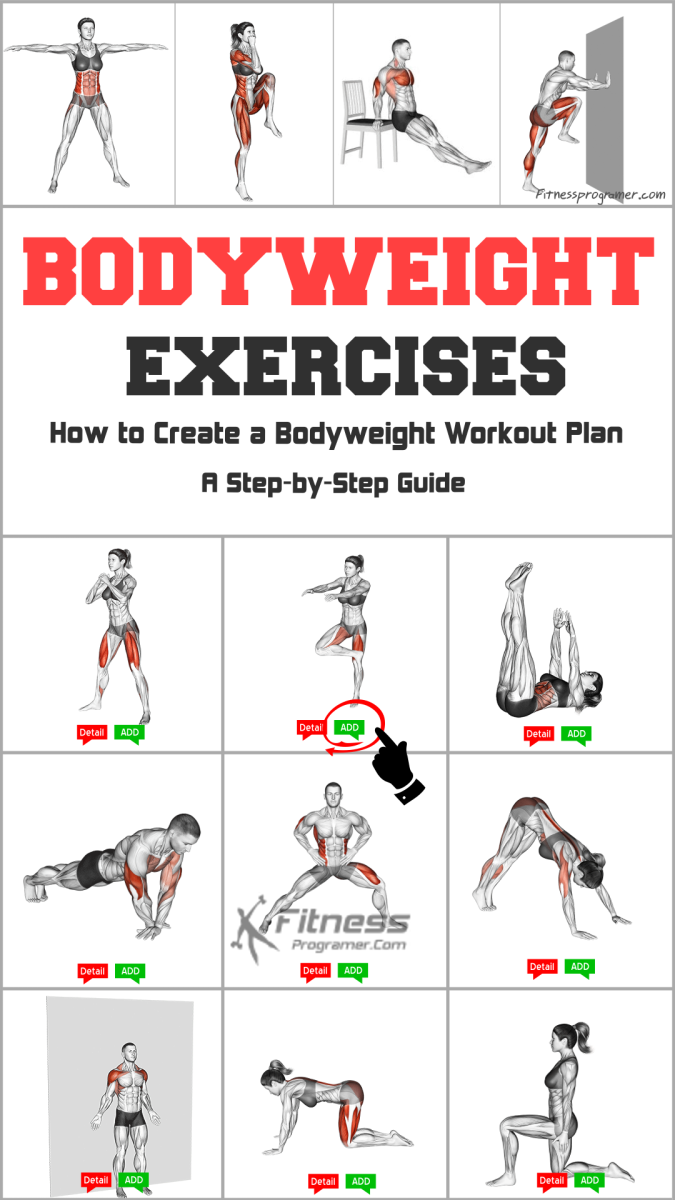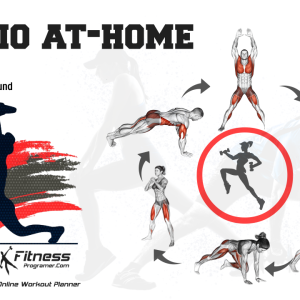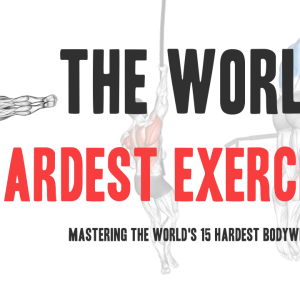Contents
Bodyweight workouts are a type of exercise that uses only the weight of the body as resistance. These workouts are gaining popularity because they don’t require any equipment, gym membership, or specialized training. If you’re new to working out, bodyweight exercises can be a great place to start.
Here are some benefits of bodyweight workouts
Resistance training: Bodyweight workouts use the weight of the body as resistance, which can help build muscle and improve strength. When you perform bodyweight exercises, your muscles must work against the resistance provided by your bodyweight, which can help to stimulate muscle growth.
Cost-effective: One of the main advantages of bodyweight workouts is that they are very cost-effective. You don’t need to pay for a gym membership or invest in expensive exercise equipment to get a good workout. All you need is some space and your own bodyweight.
Convenience: Another benefit of bodyweight workouts is that you can do them anywhere, anytime. You don’t need to commute to a gym or worry about scheduling your workout around gym hours. Bodyweight exercises can be done in the comfort of your own home, at a park, or even in your office.
Versatility: Bodyweight workouts are very versatile and can be customized to your fitness level and goals. Whether you’re a beginner or an advanced athlete, there are bodyweight exercises that can challenge you and help you achieve your fitness goals.
Improved functional strength: Bodyweight workouts focus on functional strength, which is the ability to move your body through different ranges of motion. This type of strength is important for everyday activities like lifting objects, climbing stairs, and carrying groceries.
Increased flexibility: Many bodyweight exercises require you to move through a full range of motion, which can improve your flexibility and range of motion over time.
Cardiovascular benefits: Bodyweight workouts can also provide cardiovascular benefits, especially when done in a high-intensity interval training (HIIT) format. HIIT workouts can improve your heart health and help you burn calories.
In summary, bodyweight workouts are a cost-effective, convenient, and versatile way to get fit without needing a gym membership or expensive equipment. They can improve functional strength, flexibility, and cardiovascular health, making them a great option for anyone looking to improve their overall fitness.
How to Create a Bodyweight Workout Plan
Creating a bodyweight workout plan can be a great way to get fit and stay in shape. Here’s a step-by-step guide on how to create a bodyweight workout plan:
1- Determine your fitness level: Before creating a workout plan, it’s important to determine your current fitness level. This will help you choose exercises that are appropriate for your level of fitness.
2- Define your goals: What do you want to achieve with your workout plan? Do you want to build strength, increase endurance, or lose weight? Defining your goals will help you create a workout plan that is tailored to your specific needs.
3- Choose exercises: Once you’ve determined your fitness level and goals, it’s time to choose exercises. There are many bodyweight exercises to choose from, including squats, lunges, push-ups, planks, and burpees. Choose exercises that target the muscle groups you want to work on and that are appropriate for your fitness level.
4- Create a routine: Once you’ve chosen exercises, it’s time to create a routine. Enter your membership and create a free routine. Your routine should include a variety of exercises that target different muscle groups. You should also consider incorporating cardio exercises like jumping jacks, high knees, or running in place.
5- Determine reps and sets: For each exercise, determine how many reps and sets you want to do. If you’re just starting out, you may want to start with fewer reps and sets and gradually increase over time.
6- Schedule your workouts: It’s important to schedule your workouts and make them a regular part of your routine. Determine how many days a week you want to work out and what time of day works best for you.
7- Increase gradually: As you get more comfortable with bodyweight exercises, you can gradually increase the intensity by adding more reps, sets, or variations to each exercise. However, it’s important to listen to your body and avoid overdoing it, as this can lead to injury.
8- Monitor progress: Finally, monitor your progress and make adjustments to your workout plan as needed. If you’re not seeing the results you want, you may need to adjust your routine or increase the intensity of your workouts.
Note: Consistency is key when it comes to fitness. Try to set aside time each day to do a bodyweight workout, even if it’s just for 10-15 minutes. Over time, you’ll start to see the benefits of regular exercise.
In summary, creating a bodyweight workout plan involves determining your fitness level and goals, choosing exercises, creating a routine, determining reps and sets, scheduling your workouts, and monitoring your progress. With a well-designed workout plan, you can achieve your fitness goals and improve your overall health and wellbeing.
20 Exercises For Bodyweight Workout
Incorporating a variety of bodyweight exercises into your workout routine can help keep your workouts interesting and effective. Here are 20 bodyweight exercises that you can incorporate into your routine:
Wall slides
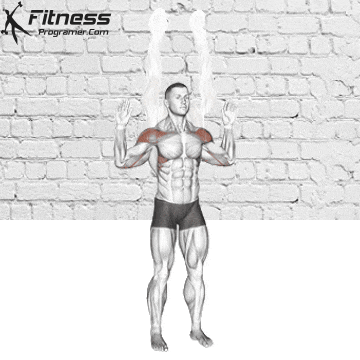
Wall slides are a great exercise for improving posture and strengthening the upper back and shoulders. Stand with your back against a wall, with your arms straight and pressed against the wall at shoulder height. Slowly slide your arms up the wall as far as you can, making sure to keep your elbows and wrists in contact with the wall. Slowly lower your arms back down to starting position, and repeat.
Squats
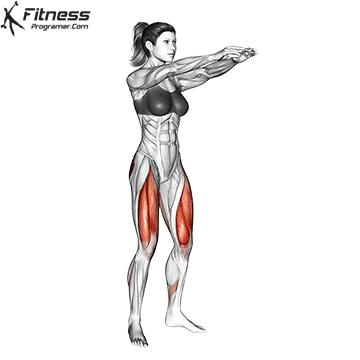
Squats are an effective functional exercise for building leg strength and toning the hip muscles. To perform a squat, stand with your feet shoulder-width apart, toes pointing slightly outward. Lower your body by bending your knees and pushing your hips back, keeping your chest up and your back straight. Aim to lower your body until your thighs are parallel to the ground, and then push through your heels to return to standing. Variations include adding a jump or holding weights to increase the intensity.
Push-ups

The push-up is a classic strengthening exercise that works the chest, shoulders and triceps. Start in a plank position with your hands shoulder-width apart, fingers pointing forward. Lower your body by bending your elbows, keeping your body in a straight line, and then push back up to starting position. Variations include doing push-ups on your knees or on an incline, or adding a plyometric jump or a shoulder tap.
Pull-up
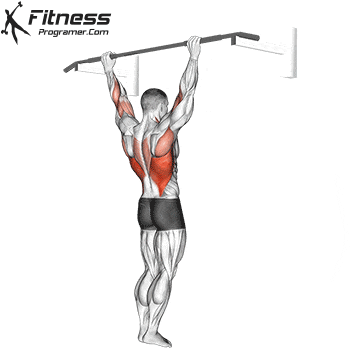
Pull-ups are a challenging exercise that target the back, shoulders, and arms. Start by hanging from a pull-up bar with your palms facing away from you, hands shoulder-width apart. Pull yourself up towards the bar until your chin is above the bar, and then slowly lower yourself back down to starting position.
Burpees
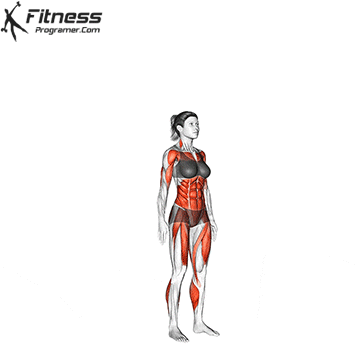
Burpees are a full-body exercise that can get your heart rate up quickly. Start by standing with your feet shoulder-width apart, then squat down and place your hands on the ground. Jump your feet back to a plank position, then do a push-up. Jump your feet back up to your hands, and then jump up explosively, reaching your arms overhead.
Mountain climbers
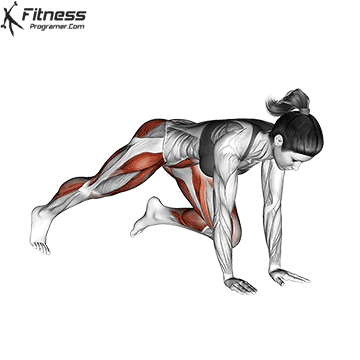
Mountain climbers are another full-body exercise that can get your heart rate up. Start in a plank position, with your hands shoulder-width apart and your body in a straight line. Bring one knee toward your chest, then quickly switch legs, keeping your hips level. Continue alternating legs as quickly as you can, making sure to engage your abs and keep your back straight.
Pike push-up
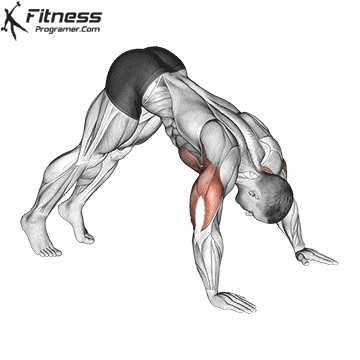
Pike push-ups are a great exercise for targeting the shoulders, chest, and triceps, as well as improving core stability. Start in a downward dog position with your hands shoulder-width apart and your feet hip-width apart. Walk your hands back towards your feet, lifting your hips up towards the ceiling and keeping your legs straight. Bend your elbows and lower your head down towards the ground, keeping your elbows close to your body. Push back up to starting position, and repeat.
Lunge
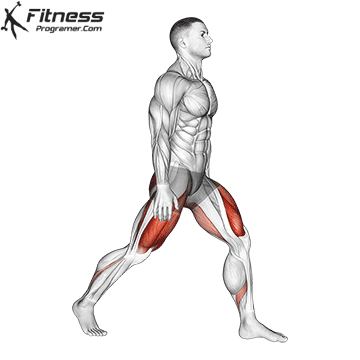
Lunges are another great exercise for building leg strength and stability. Start by standing with your feet hip-width apart, then step forward with one leg and lower your body until both knees are bent at a 90-degree angle. Push through the heel of your front foot to return to standing, and then repeat on the other side. Variations include adding a jump, holding weights, or performing reverse or lateral lunges.
Glute Bridge
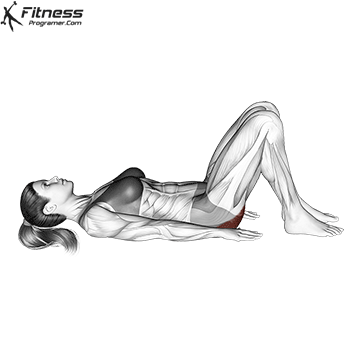
Glute bridges are another effective exercise for targeting the glutes and hamstrings, as well as the lower back and core. Lie on your back with your knees bent and feet hip-width apart. Drive through your heels and lift your hips up toward the ceiling, squeezing your glutes at the top of the movement. Lower your hips back down to the starting position, and then repeat.
Chair dips
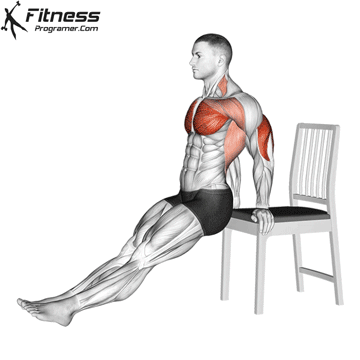
Chair dips are a great exercise for targeting the triceps and strengthening the shoulders and chest. Start by sitting on the edge of a chair or bench with your hands on either side of your hips, fingers facing forward. Walk your feet forward and lift your hips off the chair, straightening your arms. Bend your elbows and lower your body down towards the floor, keeping your back close to the chair. Push back up to starting position, and repeat.
Planks
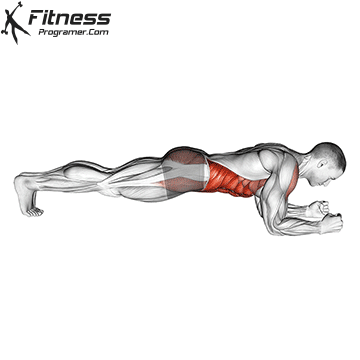
Planks are a great exercise for strengthening the core and improving posture. Start in a push-up position, with your elbows on the ground and your body in a straight line. Hold this position for as long as you can, making sure to engage your abs and keep your hips level. Variations include side planks, plank jacks, or adding leg lifts or mountain climbers.
Wall sit
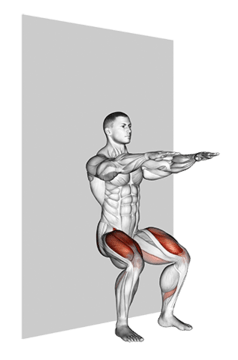
Wall sits are a great exercise for targeting the quadriceps and improving lower body strength and endurance. Stand with your back against a wall, feet shoulder-width apart and a few feet away from the wall. Lower your body down until your thighs are parallel to the ground, keeping your back against the wall and your knees directly above your ankles. Hold this position for as long as you can, and then stand back up.
Bulgarian split squat
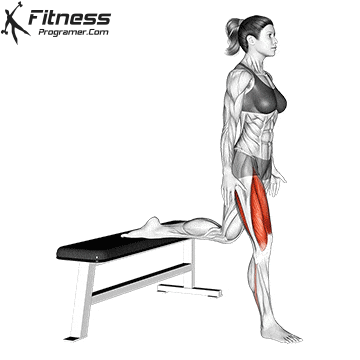
The Bulgarian split squat is an excellent exercise for targeting the glutes, quads, and hamstrings, as well as improving balance and stability. Stand a few feet in front of a bench or chair, with one foot resting on the bench behind you and the other foot planted firmly on the ground in front of you. Lower your body down until your front thigh is parallel to the ground, keeping your back straight and your knee directly above your ankle. Push back up to starting position, and repeat.
Side lying clam
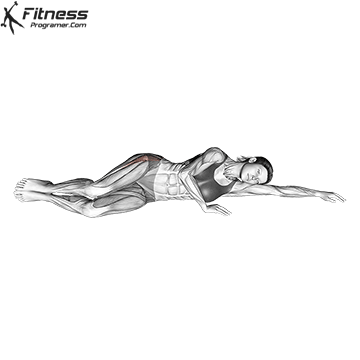
Side lying clam is a great exercise for targeting the glutes, especially the gluteus medius. Lie on your side with your legs bent at a 90-degree angle, with your feet and knees together. Keeping your feet together, lift your top knee up as high as you can without moving your pelvis or lifting your feet off the ground. Lower your knee back down to starting position, and repeat.
Donkey kicks
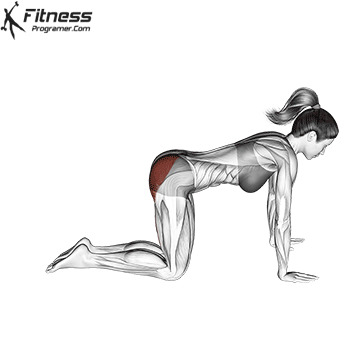
Donkey kicks are a great exercise for targeting the glutes and hamstrings. Start on all fours, with your hands shoulder-width apart and your knees hip-width apart. Keeping your right knee bent, lift your leg up and back, keeping your foot flexed and your thigh parallel to the ground. Lower your leg back down to the starting position, and then repeat on the other side.
Split squat
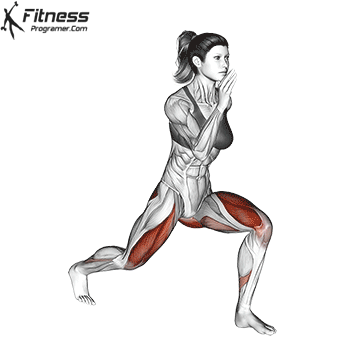
Split squats are a effective exercise for targeting the quads, hamstrings, and glutes, as well as improving balance and stability. Start in a lunge position with one foot in front of the other, keeping your back straight and your core engaged. Lower your back knee down towards the ground, keeping your front knee directly above your ankle.
Bodyweight hip thrust
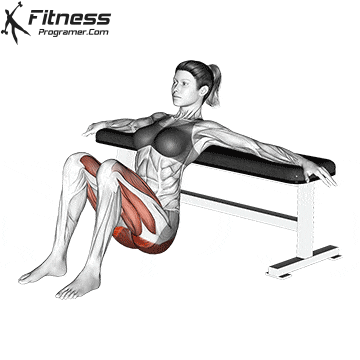
Bodyweight hip thrusts are a great exercise for targeting the glutes and hamstrings, as well as improving lower back and hip strength. Lie on your back with your knees bent and your feet hip-width apart. Lift your hips up towards the ceiling, squeezing your glutes at the top of the movement. Lower your hips back down to the starting position, and repeat.
Towel Leg Curl
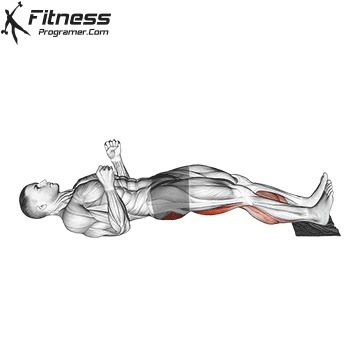
Towel leg curl is a bodyweight exercise that targets the hamstrings, glutes, and lower back. To perform the exercise, lie on your back with your feet on a towel, hip-width apart. Lift your hips off the ground and slide your feet towards your body, keeping your heels on the towel. Slowly extend your legs back out to the starting position and repeat.
Dead Bug
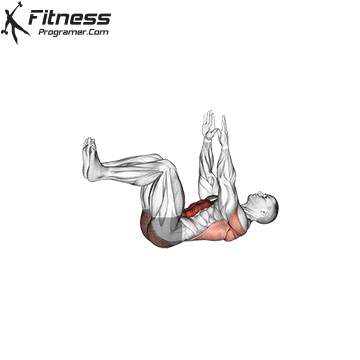
Dead bug is a bodyweight exercise that targets the abs, lower back, and hip flexors. It’s a simple yet effective exercise that can help improve core strength and stability. To perform the exercise, lie on your back with your arms extended towards the ceiling and your knees bent at a 90-degree angle. Slowly lower your right arm and left leg towards the ground, keeping your lower back pressed into the floor. Return to the starting position and repeat with your left arm and right leg. Continue alternating sides, making sure to keep
Bicycle Crunch
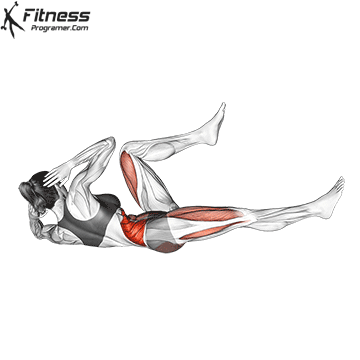
Bicycle crunch is a bodyweight exercise that targets the abs, obliques, and hip flexors. To perform the exercise, lie on your back with your hands behind your head and your knees bent. Lift your shoulders off the ground and bring your right elbow to your left knee while straightening your right leg. Switch sides, bringing your left elbow to your right knee while straightening your left leg. Continue alternating sides, pedaling your legs like a bicycle.
Sample Bodyweight Workout:
These types of workouts can be done anywhere, anytime, and are great for building strength, endurance, and improving overall fitness. Here’s an example bodyweight workout:
- Warm-up: 5 min of light cardio
- Squat: 2 x 20
- Push-up: 2 x 20
- Towel Leg Curl: 2 x 20
- Chair dips: 2 x 20
- Hip thrust: 2 x 20
- Mountain climber: 2 x 20
- Dead bug: 2 x 20
- Cool-down: 5-10 minutes of stretching
The Bottom Line
When incorporating these exercises into your workout routine, it’s important to choose a variety of exercises that target different muscle groups. You should also vary the number of reps and sets you do for each exercise to keep your muscles challenged and avoid plateauing. Additionally, consider incorporating high-intensity interval training (HIIT) into your routine by doing each exercise for a set amount of time (such as 30 seconds) with short periods of rest in between.
Remember to always warm up before starting your workout, and cool down and stretch afterward to prevent injury and reduce muscle soreness. With these 20 bodyweight exercises, you can create a fun, effective workout routine that helps you reach your fitness goals. Click on the image for other bodyweight exercises.


